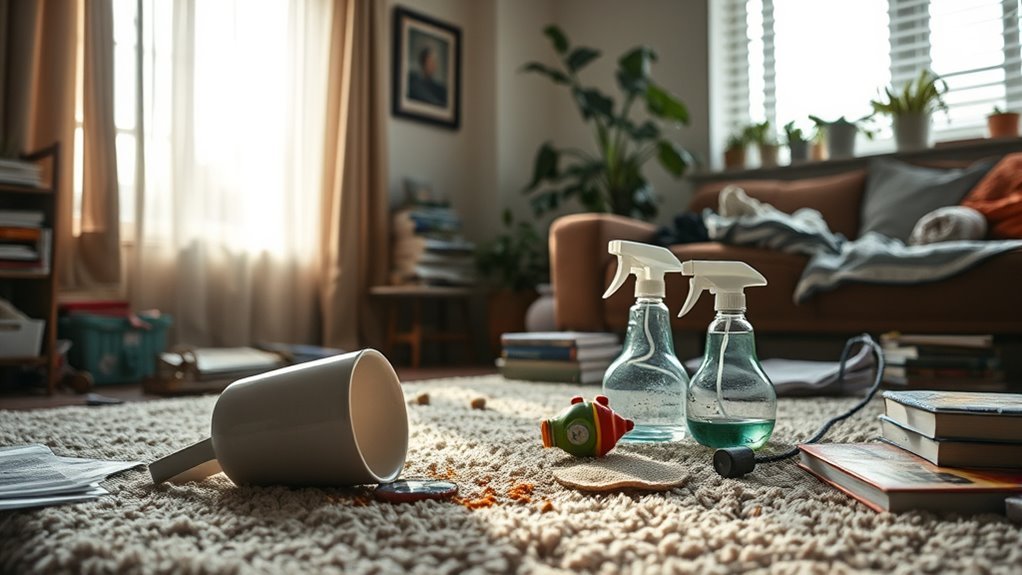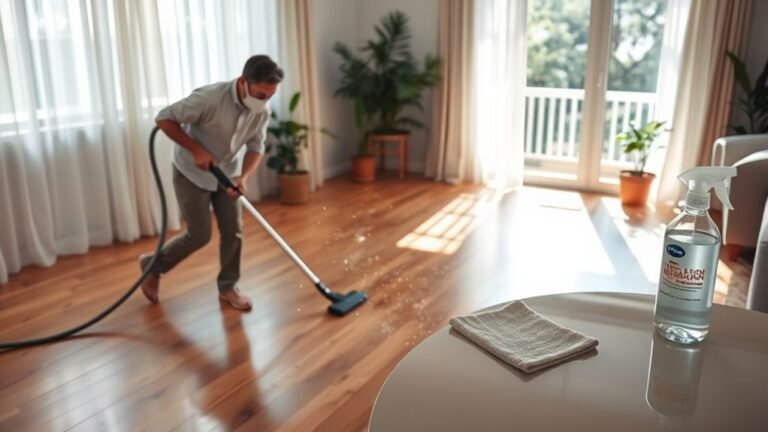Mistakes to Avoid When Cleaning Your Living Room
When cleaning your living room, don’t skip testing products first—harsh cleaners can damage delicate surfaces or fabrics. Always dust before vacuuming to avoid pushing dust around, and use the right tools for each material to prevent scratches or stains. Regular maintenance prevents buildup and keeps your space fresh. Don’t forget to clean hidden spots, or dirt will accumulate unnoticed. If you want to avoid these common pitfalls and keep your living room looking great, there’s more helpful advice ahead.
Using Harsh Chemicals on Delicate Surfaces
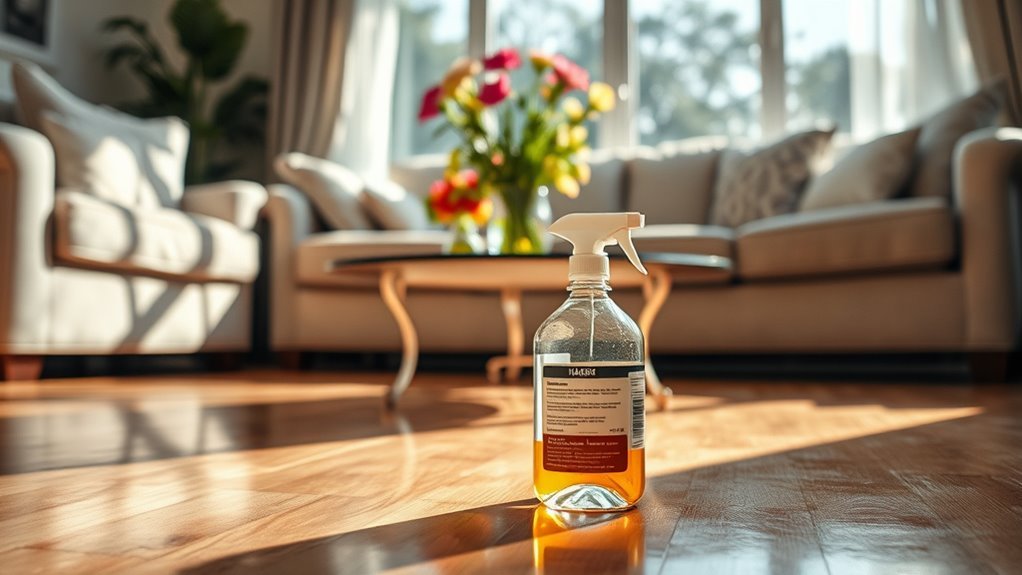
Although it might be tempting to reach for strong cleaners, using harsh chemicals on delicate surfaces can cause permanent damage. You want your living room to feel free and inviting, not restricted by ruined finishes or discoloration. Instead, opt for cleaner alternatives like mild soaps, vinegar solutions, or specialized products designed for sensitive materials. These choices not only clean effectively but also preserve the integrity of your furniture, glass, or wood. Surface protection is key — by choosing gentler options, you maintain that freedom to enjoy your space without worrying about irreversible harm. Remember, taking a gentle approach respects your belongings and helps keep your living room beautiful and functional for years to come.
Ignoring Upholstery and Fabric Care
You can’t just spray any cleaner on your couch and hope for the best. Spot cleaning with fabric-safe products is key to keeping your upholstery looking fresh without causing damage. Let’s go over some simple techniques to tackle stains the right way.
Spot Cleaning Techniques
One common mistake people make when spot cleaning is overlooking the specific needs of upholstery and fabric. You want to tackle stains quickly, but using the wrong approach can make things worse. When you spot clean, always test your cleaning techniques on a hidden area first to avoid discoloration or damage. Use a gentle blotting motion instead of rubbing—that helps lift stains without pushing them deeper. Remember, less is more; over-wetting can lead to mold or watermarks. Also, choose the right tool—a soft cloth or sponge works better than a rough brush. By paying attention to these spot cleaning details, you’ll keep your living room looking fresh and inviting without feeling trapped by complicated or damaging cleaning routines.
Fabric-Safe Cleaning Products
When selecting cleaning products for your living room, it’s essential to choose those that are safe for upholstery and fabrics. Ignoring product safety can lead to discoloration, damage, or weakened fibers, limiting your freedom to enjoy your space. You want cleaning solutions that respect fabric care guidelines, ensuring your furniture stays vibrant and intact. Always check labels for compatibility with your materials and avoid harsh chemicals that can cause long-term harm. Opt for gentle, fabric-safe products designed to protect rather than strip away. By prioritizing product safety, you maintain the integrity of your living room’s textiles while freeing yourself from costly repairs or replacements. Remember, smart fabric care isn’t just about cleaning—it’s about preserving your room’s comfort and style for years to come.
Neglecting to Dust Before Vacuuming
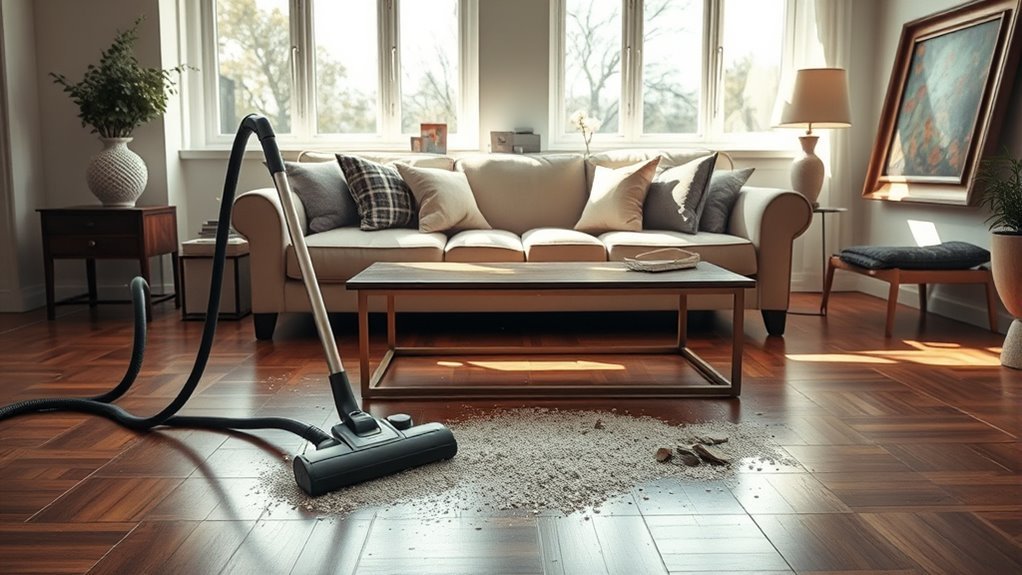
Although vacuuming might seem like the natural first step, skipping dusting can leave your living room less clean than you’d expect. When you neglect proper dusting techniques before vacuuming, dust settles back onto surfaces, forcing you to clean twice. To embrace a more liberating cleaning routine, follow this vacuuming order:
Vacuuming first can push dust around; dust before vacuuming to truly clean your living room.
- Dust all surfaces first—shelves, lampshades, and baseboards—so dust particles fall to the floor.
- Use a microfiber cloth or duster to trap dust effectively, avoiding spreading it around.
- Vacuum last to capture all dust and debris on the floor, freeing your space from hidden dirt.
Overlooking the Importance of Regular Maintenance
If you don’t keep up with regular maintenance, your living room can quickly lose its fresh, inviting feel. Skipping routine cleaning might seem like a time-saver, but it only leads to more stubborn dirt and clutter piling up. To enjoy a space that feels open and free, set a clear maintenance schedule that suits your lifestyle. This way, you avoid overwhelming chores and keep messes from taking over. Regular upkeep not only preserves your living room’s appearance but also boosts your comfort and peace of mind. Remember, cleaning isn’t about restriction—it’s about creating a space where you can truly relax and express yourself. By sticking to a routine, you’ll maintain that sense of freedom and freshness effortlessly.
Using the Wrong Tools for Different Surfaces
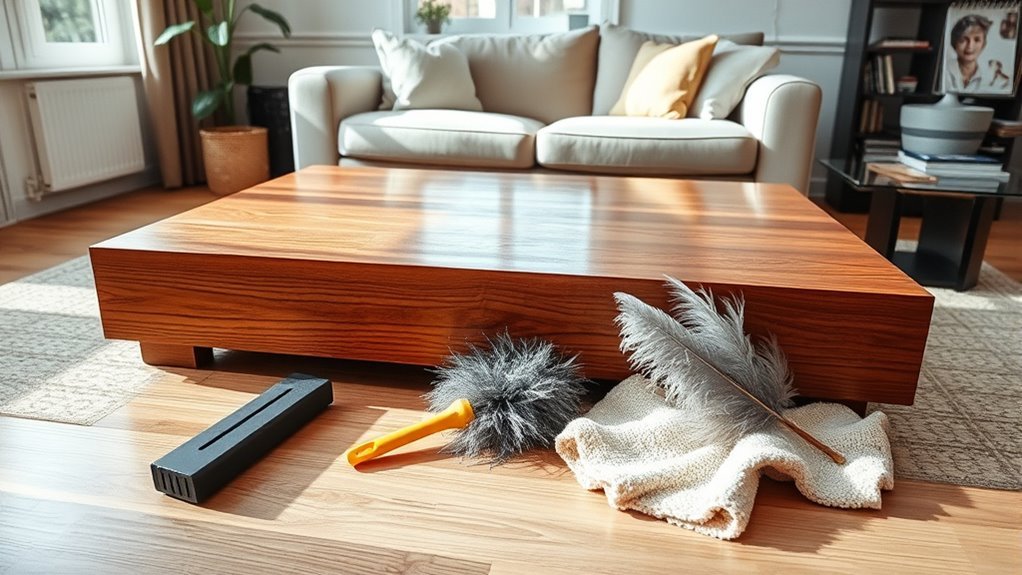
You need to know what materials your living room surfaces are made of before you start cleaning. Using the right tools for each surface helps prevent damage and keeps everything looking great. Avoid abrasive equipment that can scratch or wear down delicate finishes.
Identify Surface Materials
Knowing the type of surface you’re dealing with is key to choosing the right cleaning tools. Different surface types—wood, glass, fabric—each demand specific care to preserve their integrity. If you don’t consider material compatibility, you risk damaging your living room’s charm and your freedom to enjoy it fully.
Here’s how to identify surface materials to protect your space:
- Inspect texture and sheen: Smooth and glossy often means glass or polished wood; rough or soft indicates fabric or untreated wood.
- Check manufacturer labels or tags: They often reveal material type and cleaning instructions.
- Test a hidden spot: Apply water or cleaner gently to see how the surface reacts before full cleaning.
Knowing your surfaces means keeping your living room safe and spotless without restrictions.
Match Tools Appropriately
Choosing the right cleaning tools for each surface in your living room can make all the difference in maintaining its appearance and durability. If you want to keep your space looking fresh without damage, you’ve got to respect surface compatibility. Using harsh brushes on delicate wood or rough sponges on glass won’t just waste your effort—it could cause scratches or dullness. Instead, pick cleaning tools designed for specific materials: microfiber cloths for electronics and glass, soft brushes for upholstery, and gentle mops for hardwood floors. This way, you’re not just cleaning—you’re protecting your living room’s character and freedom to shine. When you match your tools appropriately, you save time and keep everything looking its best, letting you enjoy your space without worry.
Avoid Abrasive Equipment
Although it might seem easier to grab whatever cleaning tool is on hand, using abrasive equipment on delicate surfaces can cause lasting damage. You want your living room to feel open and inviting, not marred by scratches or dullness from the wrong cleaning tools. Protecting surfaces means choosing tools that respect their texture and finish, giving you freedom from worry.
Here’s what to keep in mind:
- Avoid steel wool or rough scrubbers on wood or glass—they’ll leave scratches you can’t erase.
- Skip harsh brushes on leather or fabric; they wear down fibers and ruin softness.
- Use soft microfiber cloths or sponges suited for each surface to maintain beauty and longevity.
Prioritize surface protection and reclaim control over your living room’s care with the right cleaning tools.
Forgetting to Clean Hidden or Hard-to-Reach Areas
When you clean your living room, it’s easy to overlook hidden or hard-to-reach spots like under the sofa or behind the entertainment center. These hidden corners often collect dust and allergens, affecting air quality and overall comfort. To keep your space truly fresh, don’t skip these areas. Make them a part of your regular cleaning schedule. Use tools like extendable dusters or vacuum attachments to reach tight spaces without hassle. Remember, freedom in your living space means breathing easy and feeling relaxed, which starts with thorough cleaning. By tackling these neglected spots consistently, you prevent buildup and maintain a healthier environment. So, next time you clean, give those hidden corners the attention they deserve—it’s a small effort with big benefits.
Not Testing Cleaning Products Before Use
After you’ve tackled those tricky hidden spots, the next step is to be careful with the cleaning products you use. Skipping the step to test a small area can lead to damage or discoloration, which restricts your freedom to enjoy a spotless living room. Always check cleaning product compatibility with your furniture and surfaces before going all in.
Here’s why you should never skip testing:
- Protect your belongings from unexpected stains or damage.
- Avoid wasting time and money on products that don’t work well.
- Keep your living space looking fresh without regrets.
Frequently Asked Questions
How Often Should I Deep Clean My Living Room Carpets?
You should deep clean your living room carpets every 12 to 18 months to keep them fresh and looking great. Following carpet cleaning frequency guidelines helps prevent dirt buildup and allergens from taking over your space. If you have pets or kids, you might want to do it more often, like every 6 to 12 months. Regular deep cleaning lets you enjoy a clean, inviting room without feeling tied down by constant chores.
What Are the Best Natural Cleaning Alternatives for Living Rooms?
If you’re aiming for eco friendly solutions in your living room, homemade cleaners are a fantastic choice. You can easily whip up a mix of vinegar, water, and a bit of lemon juice for surfaces, or baking soda for carpets and upholstery. These natural ingredients clean effectively without harsh chemicals, letting you enjoy a fresh, healthy space while staying true to your desire for freedom and simplicity in your home care routine.
How Can I Remove Pet Odors From Living Room Furniture?
If you’re dealing with pet odor on your living room furniture, start by sprinkling baking soda over the fabric—it’s a natural deodorizer. Let it sit for 15-20 minutes, then vacuum thoroughly. For deeper furniture cleaning, mix equal parts water and white vinegar in a spray bottle, lightly mist the area, and let it air dry. This combo tackles odors without harsh chemicals, giving you fresh furniture and the freedom to relax without the smell of pet odor lingering around.
Is It Safe to Use a Steam Cleaner on All Living Room Surfaces?
When it comes to steam cleaner safety, you’ve got to evaluate surface compatibility first. Not all living room surfaces can handle the high heat and moisture from a steam cleaner. Delicate materials like hardwood, unsealed stone, or certain fabrics might get damaged. So, you’ll want to check manufacturer guidelines or test a small spot before full use. This way, you get a fresh space without risking your furniture or floors.
What’S the Best Way to Organize Cleaning Supplies for Living Rooms?
When it comes to organizing your cleaning supplies, using cleaning caddies is a game-changer. They let you keep everything in one spot, so you don’t waste time hunting for products. Choose lightweight, portable caddies with compartments to separate cleaners, cloths, and brushes. This way, your supply organization stays simple and flexible, giving you the freedom to tackle any living room mess quickly and efficiently without feeling bogged down by clutter.
